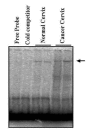Downregulation of calcineurin activity in cervical carcinoma
- PMID: 15801986
- PMCID: PMC1087859
- DOI: 10.1186/1475-2867-5-7
Downregulation of calcineurin activity in cervical carcinoma
Abstract
BACKGROUND: Calcineurin (CaN) is an important serine-threonine phosphatase (PP2B), which plays a crucial role in calcium-calmodulin mediated signal transduction events. Calcineurin has been implicated in pathogenesis of various diseases cardiac hypertrophy, diabetic neuropathy and Alzheimer's, however its role in neoplasia remains unclear. RESULTS: In view of this we evaluated the calcineurin activity in serum and biopsy samples collected from women diagnosed with invasive squamous cell carcinoma of cervix. A significant reduction was observed in the calcineurin activity in cancer cervix patients compared to the control group. However the calcineurin activity remained unaltered in the cervical scrapes obtained from patients diagnosed with low-grade squamous intra epithelial lesions (LSIL). Interestingly the downregulation of calcineurin activity in squamous cell carcinomas was not accompanied by any significant change in DNA-binding affinity of the transcriptional factor NFAT (Nuclear Factor of Activated T-cells). All the squamous cell carcinoma samples used in the present study were positive for high-risk human papillomavirus (HPV) types. CONCLUSION: The present study demonstrates the downregulation of calcineurin activity in squamous cell carcinoma of cervix with high risk HPV infection. We conclude that perturbations in calcineurin-mediated pathway may be involved in development of cervical neoplasia.
Figures





Similar articles
-
Human papillomavirus (HPV) oncoprotein E6 facilitates Calcineurin-Nuclear factor for activated T cells 2 (NFAT2) signaling to promote cellular proliferation in cervical cell carcinoma.Exp Cell Res. 2018 Jan 1;362(1):132-141. doi: 10.1016/j.yexcr.2017.11.010. Epub 2017 Nov 9. Exp Cell Res. 2018. PMID: 29129565
-
Calcineurin/NFAT coupling participates in pathological, but not physiological, cardiac hypertrophy.Circ Res. 2004 Jan 9;94(1):110-8. doi: 10.1161/01.RES.0000109415.17511.18. Epub 2003 Dec 1. Circ Res. 2004. PMID: 14656927
-
Risk factors for cervical neoplasia in Denmark.APMIS Suppl. 1998;80:1-41. APMIS Suppl. 1998. PMID: 9693662
-
Calcium-calcineurin signaling in the regulation of cardiac hypertrophy.Biochem Biophys Res Commun. 2004 Oct 1;322(4):1178-91. doi: 10.1016/j.bbrc.2004.07.121. Biochem Biophys Res Commun. 2004. PMID: 15336966 Review.
-
A Low-Risk HPV-Associated Well-Differentiated Squamous Cell Carcinoma of the Cervix with Low-Grade Squamous Intraepithelial Lesion Morphology: Clinical and Pathologic Diagnostic Difficulties and Review of the Literature.Turk Patoloji Derg. 2024;40(3):196-201. doi: 10.5146/tjpath.2024.13189. Turk Patoloji Derg. 2024. PMID: 38530111 Free PMC article. Review.
Cited by
-
Quantitative gene expression assessment identifies appropriate cell line models for individual cervical cancer pathways.BMC Genomics. 2007 May 10;8:117. doi: 10.1186/1471-2164-8-117. BMC Genomics. 2007. PMID: 17493265 Free PMC article.
-
Natural Compound Modulates the Cervical Cancer Microenvironment-A Pharmacophore Guided Molecular Modelling Approaches.J Clin Med. 2018 Dec 15;7(12):551. doi: 10.3390/jcm7120551. J Clin Med. 2018. PMID: 30558287 Free PMC article.
-
Cardiac glycoside induces cell death via FasL by activating calcineurin and NF-AT, but apoptosis initially proceeds through activation of caspases.Apoptosis. 2007 Feb;12(2):307-18. doi: 10.1007/s10495-006-0626-3. Apoptosis. 2007. Retraction in: Apoptosis. 2013 Jul;18(7):910. doi: 10.1007/s10495-013-0853-3. PMID: 17203245 Free PMC article. Retracted.
-
Calcineurin B stimulates cytokine production through a CD14-independent Toll-like receptor 4 pathway.Immunol Cell Biol. 2016 Mar;94(3):285-92. doi: 10.1038/icb.2015.91. Epub 2015 Oct 16. Immunol Cell Biol. 2016. PMID: 26471241 Free PMC article.
References
-
- Franco EL, Schlecht NF, Saslow D. The epidemiology of cervical cancer. Cancer J. 2003;9:348–59. - PubMed
-
- Bosch FX, de Sanjose S. Human papillomavirus and cervical cancer-burden and assessment of causality. J Natl Cancer Inst Monogr. 2003;31:3–13. - PubMed
-
- Shanta V, Krishnamurthi S, Gajalakshmi CK, Swaminathan R, Ravichandran K. Epidemiology of cancer of the cervix: global and national perspective. J Indian Med Assoc. 2000;98:49–52. - PubMed
-
- Pal SK, Mittal B. Improving cancer care in India: prospects and challenges. Asian Pac J Cancer Prev. 2004;5:226–8. - PubMed
LinkOut - more resources
Full Text Sources

